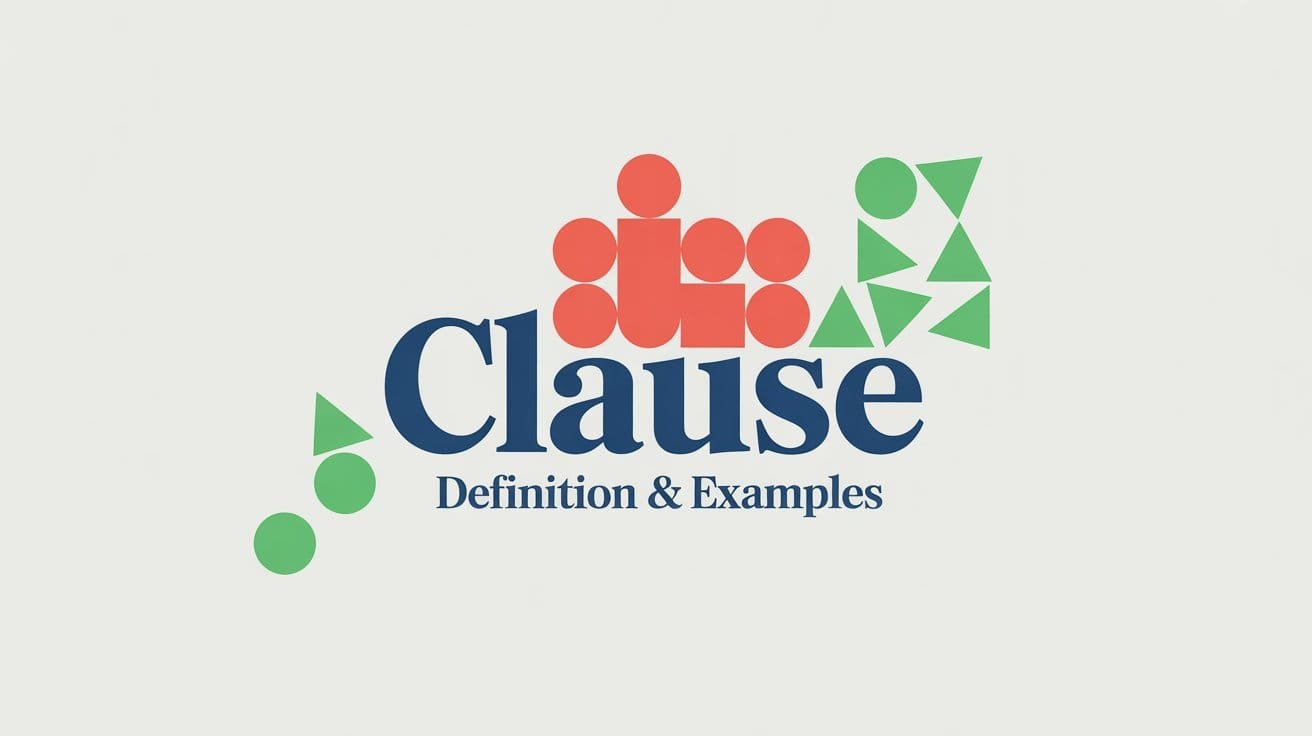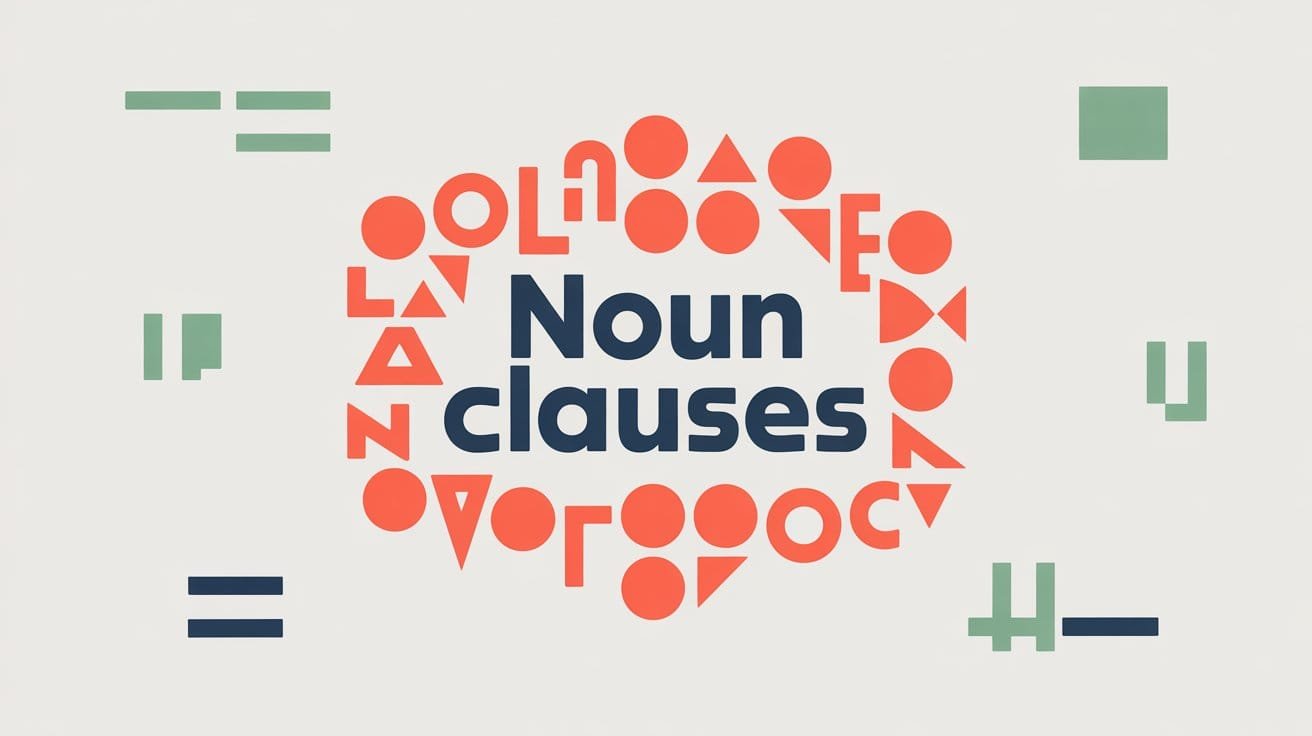Clauses are groups of words that contain a subject and a verb, and they play an important role in sentence structure. The types of clauses you use affect how your sentences are formed and how clearly your ideas come across.
This guide explains the main types of clauses in English grammar, including how each one functions within a sentence. With clear explanations and practical examples, you will learn how to identify and use clauses correctly in both writing and everyday communication.
Broad Classification of Clauses
Clauses in English are generally divided into two main categories: independent clauses and dependent clauses.
Independent (Main) Clauses
An independent clause can stand alone as a complete sentence because it expresses a full idea. It has both a subject and a verb, and does not rely on any other clause for meaning.
Examples:
- Maya enjoys reading mystery novels.
- The committee approved the final version of the report.
- Daniel enjoys hiking along the coastal trail every weekend.
- The museum reopened after months of careful renovation.
Each example forms a complete thought on its own.
Dependent (Subordinate) Clauses
A dependent clause cannot stand alone as a complete sentence. It has a subject and a verb but depends on an independent clause to make sense.
Examples:
- When Maya finishes her book
- Although Sofia agreed with the proposal
- If the roads remain closed due to flooding
- Because the presentation ran longer than expected
These clauses include a subject and a verb but do not express a full idea. They need an independent clause to complete the meaning, such as: When Maya finishes her book, she plans to start a new one.
Quick Comparison
| Feature | Independent Clause | Dependent Clause |
|---|---|---|
| Completeness | Expresses a complete thought | Depends on another clause |
| Example | The students laughed. | When the students laughed |
| Can stand alone? | Yes | No |
Independent and dependent clauses form the base of all other types of clauses in English. In the next sections, you’ll see how these categories expand into specific functional types.
Functional Types of Dependent Clauses
Dependent clauses can serve different purposes in a sentence. Based on their function, they are divided into three main types: noun clauses, adjective clauses, and adverbial clauses. Each plays a specific role and helps add depth and detail to writing.
Noun Clauses
A noun clause acts as a noun within a sentence. It can function as a subject, object, or complement. Noun clauses often begin with words like that, what, whether, who, whom, or how.
Examples:
- What you said made everyone laugh. (Subject)
- Whoever manages this account must update the data daily. (Subject)
- The teacher explained why regular practice improves writing skills. (Object)
- My concern is that the results may not be accurate. (Complement)
In each example, the clause performs the same role that a noun would.
Adjective (Relative) Clauses
An adjective clause, also called a relative clause, describes or gives more information about a noun. It usually starts with a relative pronoun such as who, which, that, or whose.
Examples:
- The journalist who covered the election published a detailed report afterward.
- I still remember the restaurant that served the best seafood in town.
- The proposal which you submitted last week has been shortlisted for review.
- The woman whose car broke down near the bridge called for assistance immediately.
Each of these adjective clauses gives extra information about a noun—journalist, restaurant, proposal, or woman—helping to describe or specify them more clearly.
Adverbial Clauses
An adverbial clause modifies a verb, adjective, or another adverb. It tells how, when, where, why, or under what condition something happens. These clauses often begin with subordinating conjunctions such as because, although, when, if, since, or while.
Examples:
- We postponed the launch because the supplier missed the shipment deadline. (Reason)
- When the lights flicker during storms, the generator starts automatically. (Time)
- Although the café was crowded, Maya managed to find a quiet corner to read. (Contrast)
- If the forecast changes overnight, the outdoor event will move indoors. (Condition)
Main Clause Types by Mood
Clauses can also be classified according to the speaker’s intention or sentence mood. This classification focuses on how a clause expresses meaning — whether it states something, asks a question, gives an instruction, or shows emotion.
There are four main clause types by mood in English: declarative, interrogative, imperative, and exclamative. Each serves a distinct function in communication.
Declarative Clauses
A declarative clause makes a statement or gives information. It’s the most common clause type in English. Declarative clauses end with a period and simply share information.
Examples:
- The team completed the task on time.
- Liam prefers coffee over tea.
Interrogative Clauses
An interrogative clause asks a question and usually begins with an auxiliary verb or a question word such as what, where, or why. These clauses always end with a question mark
Examples:
- Where did you park the car?
- Are they coming to the event?
Imperative Clauses
An imperative clause gives a command, request, or instruction. The subject you is often understood but not stated. Imperative clauses express direction or advice rather than description.
Examples:
- Close the window.
- Please finish your homework before dinner.
Exclamative Clauses
An exclamative clause shows strong emotion or surprise. It often begins with what or how and ends with an exclamation mark. These clauses add feeling and emphasis to writing or speech.
Examples:
- What a beautiful sunset!
- How exciting this day has been!
Other Clause Types Worth Knowing
Beyond the common classifications, English also includes a few specialized types of clause that appear in more advanced writing. These forms don’t always fit neatly into independent or dependent categories but still play an important role in sentence structure and variety.
Non-finite Clauses
A non-finite clause contains a verb that doesn’t show tense. These clauses often use infinitives (to write), present participles (writing), or past participles (written). They can’t stand alone but add background or extra information.
Examples:
- To reach the airport early, we left before sunrise.
- Writing quickly, Ava finished the report in time.
- Built in the 1800s, the bridge still stands today.
Verbless Clauses
A verbless clause has no stated verb but still conveys a clear idea through context. It’s often used in informal or descriptive writing.
Examples:
- If possible, send the file before noon.
- While in Madrid, they visited the royal palace.
How to Recognize and Use Each Clause Type
Recognizing different types of clause helps you understand how sentences are built and how ideas relate to each other. Once you can identify them, you’ll also know how to use them to make your writing more accurate and expressive.
Step 1: Find the Subject and Verb
Every clause has a subject (who or what the sentence is about) and a verb (the action or state). For example, “The students finished their project.” Here, “students” is the subject and finished is the verb — together they form an independent clause.
Step 2: Check if It Expresses a Complete Thought
Ask yourself whether the clause makes sense on its own. If it leaves the thought unfinished, it’s a dependent clause.
- Complete idea (independent clause): The lights turned off suddenly.
- Incomplete idea (dependent clause): When the lights turned off
Step 3: Identify Its Function
Dependent clauses can act as nouns, adjectives, or adverbs. Look at how they interact with the main clause.
Examples:
- Noun clause: I believe that honesty matters.
- Adjective clause: The book that you lent me was fascinating.
- Adverbial clause: We stayed home because it was raining.
Step 4: Use Clauses to Improve Your Writing
Different clause types help vary sentence length and tone.
Examples:
- Simple sentence: The show ended.
- Compound sentence: The show ended, and the crowd applauded.
- Complex sentence: The show ended when the lights dimmed.
Clause Types Cheat Sheet
Use this summary to review the main types of clause in English and see how each one functions within a sentence.
| Clause Type | Function / Description | Example |
|---|---|---|
| Independent Clause | Expresses a complete thought and can stand alone as a sentence. | The dog barked loudly. |
| Dependent Clause | Relies on an independent clause to make sense; cannot stand alone. | When the dog barked |
| Noun Clause | Acts as a noun (subject, object, or complement). | I know that she is right. |
| Adjective (Relative) Clause | Describes or gives more information about a noun. | The car that he bought is new. |
| Adverbial Clause | Modifies a verb, adjective, or another adverb by showing time, reason, or condition. | She smiled because she won. |
| Non-finite Clause | Uses an infinitive or participle form of a verb; adds background detail without tense. | To finish early, we started at dawn. |
| Verbless Clause | Has no stated verb but meaning is understood from context. | If necessary, call the office. |
| Declarative Clause | Makes a statement or gives information. | The concert starts at eight. |
| Interrogative Clause | Asks a question. | Where did you go? |
| Imperative Clause | Gives a command or instruction. | Please close the door. |
| Exclamative Clause | Expresses strong emotion or surprise. | What a fantastic view! |
FAQs About Types of Clauses
How many types of clauses are there in English?
There are two broad types of clauses — independent and dependent. Dependent clauses can then be divided into noun, adjective, and adverbial clauses based on how they function in a sentence.
What is the easiest way to identify a clause type?
Look for the subject and verb, then ask what the clause does. If it stands alone, it’s independent. If it describes, modifies, or acts like a noun, it’s one of the dependent types.
Can a sentence have more than one clause type?
Yes. Most sentences contain a mix of clause types. For example, I left early because I wasn’t feeling well. Here, the main clause (I left early) combines with a dependent adverbial clause (because I wasn’t feeling well).
Are non-finite clauses and dependent clauses the same?
Not exactly. Non-finite clauses often act like dependent clauses, but they use verbs that don’t show tense (infinitive or participle forms). They provide extra information without forming a complete sentence.
What’s the difference between an adjective clause and a relative clause?
There’s no real difference. The terms adjective clause and relative clause refer to the same structure — a clause that modifies a noun and usually begins with words like who, which, or that.



